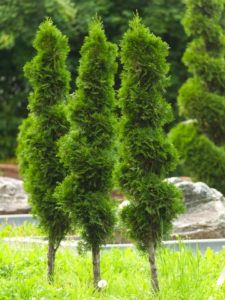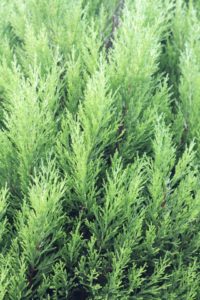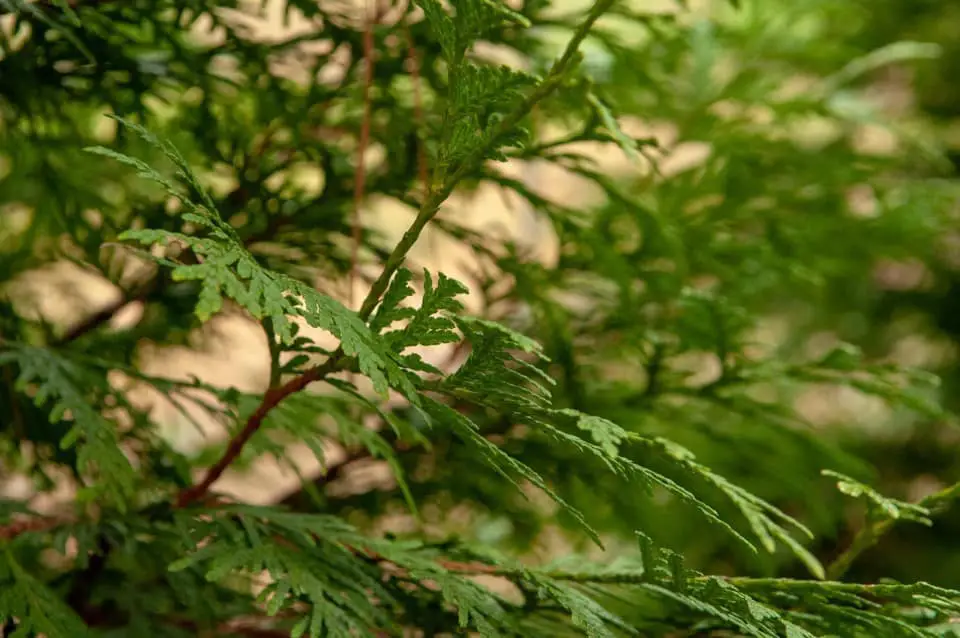Some links in the post are affiliate links and I get a commission from purchases made through some links found in the post.
Arborvitaes are so renowned for maintaining their beautiful shapes and hues that they have earned the status of “the tree of life.” So breath-taking are the arborvitae that they have featured in most landscaping magazines. And why not?
With their conical shapes and green hues, they have won the hearts of many landscapers. Are you hoping to use this tree in your next project?
We’ve come up with some ideas on how you can do so to show off the beauty that is in this tree:
How To Use An Arborvitae In Your Landscaping
Before using this tree in your home, we advise that you learn some facts about it. It helps you decide if this is the right fit for your yard, plus how you can care for it to ensure it grows optimally.
Hardiness zones
We all know how important it is to grow plants in their most suitable growing conditions. With the arborvitae, you won’t have much choice in this as you will probably grow it outdoors. Hardiness zones 2 to 8 should be suitable.
Measurements

This tree comes in many species, each featuring its set of height and width.
But for the most part, your tree will reach a height of 10 to 15 feet and a width of 3 to 5 feet.
To be sure what you can expect from your choice of species, please check with the nursery.
That way, you can tell if your yard can accommodate its growth.
Sunlight
The arborvitae does best when exposed to full sun for at least six hours a day. It can tolerate partial shade but will not do well in full shade.
So, you must find a spot that gets adequate morning or afternoon sun to support the plant’s growth.
Planting
You do not have to plant the arborvitae in the ground. Seeing as it reaches about 15 feet (4.5 meters) in height and has a shallow root system, it can also grow in pots.
Ensure you get one that can support the root ball without posing an impediment to the plant’s growth. You can as well plant the tree in the ground.
Soil
The arborvitae prefers well-draining soil. The good thing is that it can tolerate most soil types as long as you amend the draining. But if you can get a high-quality potting mix, that would be the most suitable option.
Watering
Does your tree need water? Yes! You should ensure the plant gets at least an inch of water each week during the growing season.
You can hold back on watering if it’s been raining or if the ground around the roots feels wet. Remember that it has a shallow root system, and too much watering can drown the roots.
Also, underwatering could kill your plant. Find a way to balance the watering schedule, and your plant will be okay.
How to use Arborvitae in Landscaping, Having Met the Above Requirements?
As a Hedge
Let’s start with the most common use of the arborvitae- as a privacy screen. Do you want to enjoy more privacy in your home?
Then these trees can afford you this luxury. They grow densely, ensuring that nobody can peer through them. Oh, and the best part?
They grow fast! In about two years, you should be gazing at a thick bush which is all you need to enhance your outdoors while avoiding prying eyes. We will get into how to space them for the best effects later.
For Framing
Is there any structure in your home that needs just a bit of framing? Maybe your walkway feels a bit too bland and has nothing that gives you the wow factor.
Or your driveway feels too plain and offers nothing in visual interest. Well, arborvitae can help you with that.
All you need is to line a couple of trees on the driveway, which should create just the elegant welcome that you and your guests deserve. You can already picture walking or driving under that beautiful canopy.
As an Addition
 Do you already have other plants in your home? The arborvitae blends in well with other species too.
Do you already have other plants in your home? The arborvitae blends in well with other species too.
So, you can have the tree as an addition to the rest, creating the perfect balance seen in most landscapes. Besides, you can decide if it works as the focal point or as a complementary plant.
Keep its height and width in mind as you mix and match it with other varieties for that awe-inspiring finish.
As a Topiary
Have you ever looked at sculpted trees and wondered how you could add one to your yard? Now you can, with the arborvitae.
Its fast and dense growth makes it the perfect candidate for topiary. You can play around when shaping it to reflect your landscape even better.
Or you can have a professional weigh in on the best shapes to complement the other species in your yard.
For more landscaping ideas, check out our articles on how to landscape with sleepers or how to landscape with hydrangeas.
What Looks Good Next to Arborvitae?
Arborvitae works great as a foundation plant, hedge, privacy screen, or accent plant.
With its lush hue that lasts through the year coupled with a slim shape, you would be safe to think that this tree is all you need for your garden.
But with landscaping, one plant can never be enough to achieve that coveted seamlessness where one concept blends in with the other.
So, which plants can you count on to match the beat of the arborvitae without interrupting the beauty exuded by this triangular plant?
Do you want to know the good news? You can mix virtually any plant with the arborvitae, including:
Tropical Plants
These plants require a bit more care than your standard landscaping options to look good next to a arborvitae. But if you have an eye for detail and want to put in the work, why not?
They complement the arborvitae, creating more visual interest in the space, making it even more aesthetically pleasing.
Woody Ornamentals
Choose those with heavy barks coupled with beautiful flowers. Examples include hardy blue holly and forest pansy.
When choosing any of these plants, ensure that your hardiness zone can support their growth.
Other Conifers
How about introducing more conifers to the space? While you might think that this might shade the yard too much, adequate spacing can ensure you never deal with this concern.
Grasses & Perennials
These add contrast to the arborvitae and make the space more inviting. Besides, they do not take away from its magnificent height as they remain at lower levels throughout the year.
So, if you do not want to introduce competition in the yard, that’s one way to do it. You can try choices like coral bells and variegate.
Colorful Flowers
Why not add more beauty to the yard by including bright flowers in the space? Besides, when have flowers ever not made a landscape pop more?
Remember to choose plants whose growth requirements are in line with the arborvitae. Again, it takes the workload off your hands by enabling you to use a one-size-fits-all approach.
Oh, and as you play around with other species, how about trying different arborvitae species?
Dwarf Varieties
If you hope to have shorter plants in your landscape, the shorter arborvitae plants will make a good choice. They measure about three to four feet and are easy to position in the yard.
Plus, they are easy to shape, which allows you a lot of flexibility when deciding on a look for the yard.
Tall Varieties
These varieties are the best for people hoping to get more privacy or create hedges. Given their tall heights, they are best placed along borders to avoid interrupting the flow in the landscape.
You may also like: How to landscape with potted plants
How Far Apart Should You Put Arborvitae?
 Planting trees often comes with the concern of how far apart the trees should be. If you plant them too close, they start competing for nutrients and create a thick canopy that prevents undergrowth from flourishing.
Planting trees often comes with the concern of how far apart the trees should be. If you plant them too close, they start competing for nutrients and create a thick canopy that prevents undergrowth from flourishing.
It eventually hurts your landscape because some trees don’t reach their maximum heights or appear thin and weak.
But plant the trees too far apart, and you don’t achieve the hedge or landscape you desire. So, what’s the right way to do it?
Well, you must consider the root system of the plants. Smaller trees feature roots about eight inches deep, while larger ones can reach 24 inches.
That said, you can tell that the systems are not so extensive, enabling you to grow the plants close to each other.
But how close should they be? The second consideration is how you want to use the arborvitae in landscaping. Suppose you want to create a privacy screen; you should aim for two to three feet apart.
Two feet work best for thick screens, while three feet are okay for the average screen. But if you want to grow the trees apart, you can choose just how far apart you want them to be.
Most varieties reach widths of three to five feet. So, assuming your variety reaches five feet, and you want to leave space between the trees, use this measurement when spacing the plants.
Final Thoughts: How to Use an Arborvitae in Your Landscaping
Arborvitae trees are very easy to care for and are generally low-maintenance plants. As long as you water them regularly and amend their soil, they will barely give you any trouble. Happy Gardening!
If you enjoyed this article, check out our article on ideas 4 landscaping review.


